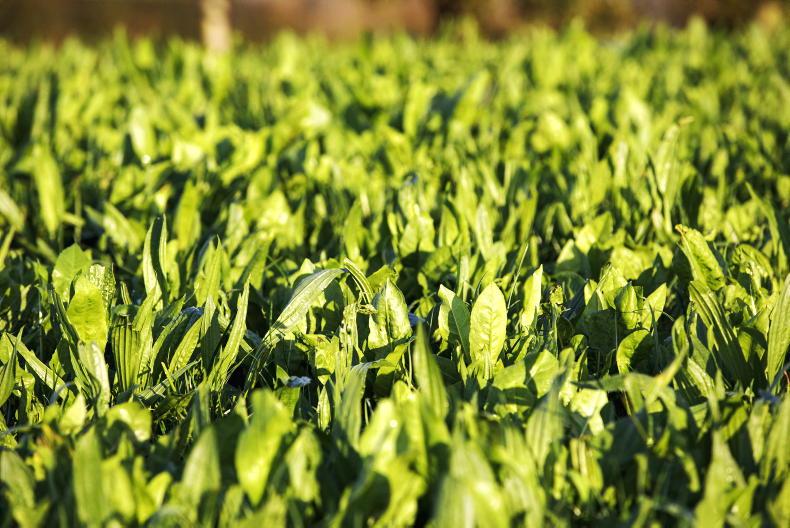Research has been ongoing into multi species swards for a long time, but farm-scale research is still in the early stages.
As farmers are now required to reduce fertiliser use, this is the first advantage these types of swards have, with up to 40% of the mixture made up of legumes. Going over the 40% mark with legumes can result in nitrate leaching. The remainder of these swards are made up of grasses and herbs.
Aside from fertiliser reductions, these swards boast many potential benefits, including increased soil health, positive effects on animal health and an improvement in drought tolerance.
In 2018 and 2020, all farms were hit by drought to some degree or another. The ones that coped the best were those with good soil structure and health.
Mixtures are a practical farm-scale mitigation action for drought
n order to ensure sustainable farm systems, we need to ensure a continuous feed supply and while extreme droughts like 2018 are rare, the fact that very dry weather hit again in 2020 means we need to find a solution to a severe hit on grass growth in this type of weather.
Multi-species swards include a mixture of root types, and different plant species can play a huge role in improving soil structure and health, in turn helping plants to tolerate drought.
Speaking at a recent Signposts webinar, Teagasc’s John Finn noted that: “Mixtures are a practical farm-scale mitigation action for drought.”
Diversity
The diversity that these sward mixtures provide can allow for better utilisation of light and nutrients, while also providing plants with a diversity of root structures, some of which can go deep into the soil profile and avail of more nutrients and water.
John commented that species decline results in ecosystem decline. He stated that where species richness is low, biomass production can decrease. He then described trial data with 11 different mixtures across 31 sites that showed 98% of mixed plots yielded more than the average monoculture plot. In the same trial, 65% of mixed plots yielded more than the best monoculture plot and overall mixture performance was approximately 20% better than the best monoculture.
Once you get good establishment, the mixtures have an incredible ability to suppress weeds
Over a three-year period, John also reported less weeds in mixed-species swards.
He noted that weed levels increased over the three-year period in the monoculture swards from approximately 15% to 30%, but remained low and at consistent levels of approximately 4% in the mixed species swards.
“Once you get good establishment, the mixtures have an incredible ability to suppress weeds,” John commented.
Nitrogen reductions
Looking at three levels of fertiliser – 50kg, 150kg and 450kg N/ha – John explained how the same yields can be achieved from 50kg N/ha where legumes take up approximately 40% of the sward as can be achieved from a monoculture receiving 450kg N/ha.
“By manipulating the legume proportion and applying only 50kg of nitrogen, we can beat a grass monoculture yield or a grass-only yield which has had 450kg N/ha applied. We can get more from less by manipulating the legume proportion in the sward.”
Drought tolerance
John then asked if these mixtures can provide insurance against drought. Trials imposing experimental drought and examining resistance in Ireland and Switzerland– sheltering plots with different numbers of species from rain over a nine-week period were carried out.
Drought can affect grass growth very quickly and can also take time to recover when moisture does return to the soil.
The ability of species richness to mitigate the effects of drought is very clear
The research examined the effect of species richness on yield in a drought situation and John explained that yield increased and variation in yields reduced with an increase in species richness.
“The ability of species richness to mitigate the effects of drought is very clear,” he added.
Changing systems is a big step on a farm and not a decision to be taken lightly. Some farmers are making a gradual move to these systems or trying out a small area on their farm, maybe just stitching in mixtures to some paddocks to see how they grow and how animals take to them.
Persistency is a concern. It’s very hard to move from a dependable perennial rye grass-based system, but as more results come from Johnstown and Moorepark on farm-based research, farmers will be armed with evidence for decision making and should weigh up the costs of reseeding or stitching in with the savings from fertiliser reductions.
The research that John presented shows the ability to grow high-yielding crops at dramatically reduced fertiliser rates and this is essential going forward if agriculture is to meet its climate targets.
These swards can help to reduce greenhouse gases such as nitrous oxide and methane.
Keeping soils healthy is a key part of fertiliser reduction and diversity in plants can create diversity in soil microbes and plant exudates, which can increase microbial activity and nutrient release, as well as helping to improve soil structure.
Healthy soils produce healthy and strong plants.







 This is a subscriber-only article
This is a subscriber-only article











SHARING OPTIONS: